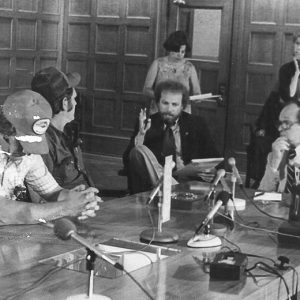calsfoundation@cals.org
Trucking Industry
The trucking industry plays a significant role in Arkansas’s agricultural and industrial life. Trucks transport many Arkansas products through and out of the state, including poultry, lumber, sand and gravel, cotton, and farm produce. Trucks also bring necessities and luxuries into Arkansas. Businesses such as Walmart Inc. and Tyson Foods Inc. rely on the trucking industry for their survival.
Although Arkansas’s location was a detriment to industrial development and the transportation that accompanied industry prior to World War II, several factors have made the state a leader in trucking since the middle of the twentieth century. Large agricultural establishments such as those of the Delta region of Arkansas were not viable in the hills of northwest Arkansas, which resulted in a new approach to entrepreneurship in that region. Innovations in agriculture, such as the emergence of the poultry industry, happened in northwest Arkansas, as did a new approach to sales advanced by Sam Walton of Walmart Inc. The building of the Interstate Highway System, which began in the 1950s, also contributed to making Arkansas a transportation hub, being surrounded by states with major cities such as Memphis, Tennessee; St. Louis, Missouri; Oklahoma City, Oklahoma; and Dallas and Houston, Texas. Finally, the national shift in population toward the South and West caused both the growth of those cities and an increased need for transportation between those cities.
History and Current Status
Before the invention of the internal combustion engine, roads in Arkansas were primitive trails used primarily to connect people to the better transportation opportunities of rivers and, in the nineteenth century, railroads. During the second decade of the twentieth century, automobiles were increasingly common in Arkansas, and roads were greatly improved. This spurred the development of the trucking industry. While trucks were still seen as a short-haul option to bring goods to the railroad stations or river ports, the use of trucks for long-distance transportation was on the rise—an inevitable result of better highways in the state.
Trucking began in Arkansas in 1919, when Harvey Jones exchanged his two mules and wagon for a Federal brand truck for his delivery route that served Rogers (Benton County), Springdale (Washington County), and Fayetteville (Washington County). Another early trucking firm in Arkansas was Hines Trucking. Established in Prescott (Nevada County) in 1936, the Hines family’s small firm began with one truck, which they used to transport logs, lumber, and gravel. Five years later, the Fikes family of Hope (Hempstead County) founded Fikes Truck Line for much the same purposes. Other trucking firms appeared after World War II. One of the most significant businesses to emerge from the second generation of trucking firms in Arkansas was J. B. Hunt Transport Services. Based in Lowell (Benton County), the company began by serving the poultry industry in northwest Arkansas and has grown to become Arkansas’s largest trucking firm.
The Arkansas trucking industry established the Shippers and Carriers Association of Arkansas in 1932. The organization evolved through several name changes and industry trends in the twentieth century, eventually becoming the Arkansas Trucking Association (ATA), which currently serves as a state advocacy and information resource to the industry. The longest-standing active member of the ATA is the national less-than-truckload (LTL) carrier ABF Freight System, which joined under the name Arkansas Motor Freight in 1934.
From 1935 to 1980, the trucking industry was regulated nationally by the Interstate Commerce Commission (ICC). Many of the rules of the ICC seemed to benefit railroads at the expense of highway transportation of goods, and leaders in the trucking industry sought deregulation, which was finally achieved by the Motor Carrier Act (MCA) of 1980. In Arkansas, as in all other states, many new trucking firms began as a result of the MCA. These include PAM Transportation, founded in Tontitown (Washington County) in 1980 (the letters in the name represent the initials of the founder, Paul A. Maestri, but are also said to stand for “Pretty Awesome Mileage”), as well as USA Truck Inc., founded in Van Buren (Crawford County) in 1980, and Arkansas Freightways, founded in Harrison (Boone County) in 1982. Arkansas Freightways changed its name to American Freightways and later was acquired by FedEx.
By July 2004, more than 524,000 U.S. carriers were on file with the U.S. Department of Transportation, including for-hire fleets, private fleets, and owner-operators. The vast majority of these are small businesses; eighty-seven percent operate six trucks or fewer. According to the ATA, over 6,295 trucking companies are located in Arkansas. Another innovation that changed the trucking industry after the MCA was intermodal services with rail and shipping companies. J. B. Hunt was one of the first trucking firms in the nation to establish such services.
Economic Impact
According to 2005 data from the American Transportation Research Institute, the Arkansas trucking industry provided 86,056 jobs, one out of thirteen in the state. Total trucking industry wages paid in Arkansas exceeded $2.5 billion, with an average annual trucking industry salary of $29,238. Trucks transported 89.04 percent of total manufactured tonnage in the state, 499,729 tons per day, with more than eighty-six percent of communities depending exclusively on trucks to move their goods. The trucking industry in Arkansas paid approximately $475 million in federal and state roadway taxes and fees. The industry paid 48.2 percent of all taxes and fees owed by Arkansas motorists, despite trucks representing only 14.1 percent of vehicle miles traveled in the state. A typical five-axle tractor-semi trailer combination paid $6,128 in state highway user fees and taxes, in addition to $8,959 in federal user fees and taxes.
Trucking firms are recognized as either truckload or less-than-truckload carriers. The truckload sector has few operating economies of scale, a large number of competitors, and low financial barriers to entry. The LTL sector is dominated by a small and shrinking group of increasingly large national firms and has large financial barriers to entry.
Safety Enforcement
Increasing motor vehicle traffic on state highways and the need to protect the state investment in roads led to the 1929 creation of the State Road Patrol under the jurisdiction of the Arkansas Highway Commission. The agency addressed size and weight enforcement to keep roads from being destroyed. It focused on regulation of overloaded trucks and other vehicles, and patrol units were equipped with testing devices for weighing vehicles believed to be in excess of permitted road and bridge weights.
Currently known as the Arkansas Highway Police, the agency, with approximately 165 officers, continues to enforce truck size and weight standards. Some 50,000 safety inspections per year are conducted roadside or at eight weigh stations. Trucking companies with a good safety record can earn a pre-pass authority. In these cases, a transponder is placed in the truck, and data transmission devices on the highway signal permission to the driver to pass weigh stations.
Arkansas and other states are members of the Commercial Vehicle Safety Association, which includes government, industry, and regulatory agencies, all geared toward safety and uniformity across the United States. With the advent of new computer-based technology, driver logbooks are rapidly being replaced by onboard recording devices, which also retain data on many levels of truck engine usage. Influenced by sleep rhythm research, changes have also been introduced in the maximum daily hours of service for truck drivers. The Arkansas Department of Transportation has converted some former weigh stations to truck parking areas, offering drivers a safe location for rest and reducing the problem of illegal parking on shoulders and ramps.
Environment
In addition to traditional recycling programs for tires and lubricants, the Arkansas Department of Environmental Quality implemented new air quality programs in January 2009 aimed at reducing emissions in high-traffic areas. These include truck stop electrification to provide power to parked vehicles and avoid engine idling, diesel engine retrofits on municipal vehicles, and vapor recovery systems to prevent diesel fumes from escaping into the atmosphere while trucks are fueling.
Management and Technology
The need for more educational preparation in marketing and logistics in the trucking industry led to the establishment of the federal Mack-Blackwell Transportation Center, located at the University of Arkansas (UA) in Fayetteville (Washington County), and the Supply Chain Management Research Center, a program of the UA Walton College of Business. Continuing technological advancement in the trucking industry includes new development of transponders and driver communication devices, advancements in diesel engine and fuel efficiencies, as well as freight packaging technology for bar coding of pallets and alternative materials for pallet construction.
Drivers and Licensing
In response to the need for professionally trained drivers, a pilot initiative for driver training was launched in 2008 at Arkansas State University–Newport and Mid-South Community College in West Memphis (Crittenden County). The program, a partnership between the Arkansas Department of Workforce Services, the Workforce Investment Board, and the Arkansas Trucking Association, aims to recruit 300 new drivers annually, with program costs provided by federal and state agencies.
In the 1980s, traffic volume, particularly heavy trucks, created maintenance problems for state highways. In 1983, in compliance with a new Federal Aid Highway Act, Arkansas increased its truck maximum weight limit to 80,000 pounds, and the state legislature passed Act 685, levying new weight-distance taxes to provide additional road maintenance funding. In 1987, the American Trucking Association filed a lawsuit challenging the constitutionality of this tax. The challenge was resolved when Act 685 was replaced by Act 219 of 1991, allowing new revenue-producing measures aimed at trucks.
The challenge of funding additional highway maintenance and capacity projects persists. In 2008, the Arkansas Highway Department projected a minimum $15 billion shortage over the next decade to meet increasing usage needs. The trucking industry continues to be held accountable for a share of those costs. In 2008, trucks accounted for eighteen percent of the daily vehicle miles traveled (DVMT) on the entire state highway system and 27.8 percent of DVMT on Arkansas interstate highways. Because trucks create more stress on the state’s highways per mile than smaller vehicles, debate continues regarding the need for the trucking industry as a whole to pay a larger share of the cost of highway maintenance.
For additional information:
Arkansas Truck Association. http://www.arkansastrucking.com/ (accessed April 11, 2022).
Casas, Miguel. “3 Trucking Companies in State Meet or Top Earnings Forecast.” Arkansas Democrat-Gazette, April 15, 1999, pp. 1D, 2D.
Schwartz, Marvin.J. B. Hunt: The Long Haul to Success. Fayetteville: University of Arkansas Press, 1992.
“Truck Lobby Group is Renamed Arkansas Trucking Association.” Arkansas Democrat-Gazette, May 20, 1999, p. 7B.
Marvin Schwartz
Little Rock, Arkansas
Staff of the CALS Encyclopedia of Arkansas

 Joe Purcell in Meeting
Joe Purcell in Meeting 



Comments
No comments on this entry yet.